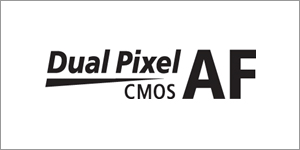News Release
Canon develops new Dual Pixel CMOS AF technology for significantly improved autofocus performance during Live View shooting and when shooting movies
TOKYO, Japan, July 2, 2013—Canon Inc. today announced the development of Dual Pixel CMOS AF, an innovative new autofocus technology for digital SLR cameras. Dual Pixel CMOS AF, a phase-difference AF technology on the image sensor plane, employs a CMOS sensor on which all of the effective pixels are able to perform both imaging and phase-difference AF to achieve dramatically improved AF performance during Live View shooting and when shooting movies.

Dual Pixel CMOS AF logo
As digital SLR cameras have evolved in recent years in terms of functionality and performance, shooting styles have become more diverse, with an increasing number of users no longer relying exclusively on the viewfinder when shooting, but rather confirming images on the camera's LCD monitor when capturing images using the Live View function and when shooting movies.
Canon's newly developed Dual Pixel CMOS AF, an innovative new image-plane phase-difference AF technology, employs a CMOS sensor on which all of the effective pixels are able to perform both imaging and phase-difference AF. Each individual pixel (the smallest structural unit capable of outputting an image signal) on the CMOS sensor incorporates two independent photodiodes (elements that transform light into electrical signals) which output signals that can be used for both imaging and the phase-difference AF. When using the Live View function, the technology makes possible shooting with a feel similar to when shooting through the viewfinder, enabling sharp focus to be obtained across a wide shooting area1 through phase-difference AF2 until final focus is achieved. Compared with Canon's previous image-plane phase-difference AF,3 Dual Pixel CMOS AF realizes shorter focusing times, exceptional tracking performance and smooth autofocusing during movie shooting. Accordingly, because Live View shooting can be used in a manner similar to using the camera's viewfinder, the fast and smooth AF performance allows users to focus more attention on the subject and composing the photo when shooting.
Compared with the EOS Kiss X7 (EOS Rebel SL1 or EOS 100D in other regions), which employs Hybrid CMOS AF II, the EOS 70D (which goes on sale in late August 2013 in select regions), the first camera to feature the new AF technology, not only achieves an approximately 30% faster4 focusing speed but also delivers improved Movie Servo AF tracking for continuously smooth focusing during movie shooting, even when filming quickly moving subjects.
Because the outstanding AF performance of Dual Pixel CMOS AF is made possible with 1035 models of EF lenses (including earlier models and models available outside of Japan), users can enjoy a wide range of photographic endeavors enabled through various lenses.
Recognizing great potential for the application of this technology across diverse product categories, Canon aims to promote its development efforts in the field of AF technology, targeting further advances to contribute to expanding the world of photographic expression.
- 1Shooting area coverage of approximately 80% vertically and horizontally for the EOS 70D.
- 2Contrast AF employed when using some older EF lens models, during magnified view, during Movie digital zoom and when using an extender.
- 3Hybrid CMOS AF and Hybrid CMOS AF II, which combine phase-difference AF and contrast AF.
- 4When used with an EF-S 18-55mm f/3.5-5.6 IS STM lens, based on a comparison by Canon. Disparity between AF methods may be small depending on lens used and shooting conditions. Disparity becomes greater when using older types of lenses.
- 5As of July 2, 2013.
Reference information
Phase-difference AF
With phase-difference AF, the light that enters through the photographic lens is divided into two images and the difference in the focus point position between the two images formed on the dedicated AF sensor is measured, enabling the camera to determine the direction and amount of lens adjustment required to obtain proper focus. Because phase-difference AF enables fast focusing performance compared with contrast AF, the technology is widely employed in digital SLR cameras, mainly for viewfinder shooting.
Since Dual Pixel CMOS AF makes possible phase-difference AF on the image sensor plane employing the same principle as with a dedicated AF sensor, an imaging sensor capable of outputting a phase-difference AF signal was developed that enables image-plane phase-difference detection AF through to the achievement of final focus.
Contrast AF
Contrast AF is an autofocus method employed in compact digital cameras and video camcorders, as well as digital SLR cameras for Live View shooting. Because contrast is highest when an image is in proper focus, the camera analyzes the contrast information from the image on the image sensor, adjusting the lens until the maximum contrast value is reached. While contrast AF offers high focusing accuracy, compared with phase-difference AF, it tends to require more time because the lens adjustment is needed to find the point of peak contrast.
Hybrid CMOS AF and Hybrid CMOS AF II
Hybrid CMOS AF is an AF method employed in entry-level EOS digital SLR cameras and the EOS M compact-system camera that delivers enhanced focusing speed during Live View shooting and when shooting movies. Combining fast contrast AF and high-accuracy phase-difference AF, Hybrid CMOS AF makes possible faster focusing performance, quickly measuring the subject distance using the dedicated phase-difference AF image element embedded in the CMOS sensor (focal plane) and completing the process with extreme accuracy using contrast AF. The EOS Kiss X7 (EOS Rebel SL1 or EOS 100D in other regions) features Hybrid CMOS AF II, which makes use of an imaging sensor that supports AF across a wide area spanning approximately 80% vertically and horizontally of the shooting area.
